Nigel J. Ross
Travelogue

Friday 28th August 2006. Alarm clock set for 4:50 in the morning, taxi booked for 5:15, everything going well until I got to the airport to find enormous queues at the Alitalia check-in desks. I eventually checked in, fifty minutes after getting to the airport at 6:20 … my flight was due to leave at 6:55. More long queues at passport control, another 20 minutes wait. I eventually got to the gate at 6:50. Luckily they were holding the flights for 10-15 minutes and so miraculously I made it, but I guess quite a few people must have missed the flight as there were a good few empty seats.
In a little over an hour we were in Paris. My first concern was to find an information desk to see if my luggage had also made it onto the plane in Milan, and it had. Just as well, as I discovered that the next flight to Brazzaville was three days later, on the Monday. We had a late departure due to “technical problems”, but we finally left on the long flight to the Congo, but I slept a good bit of the way.
Unfortunately it was already dark when we arrived. Maya Maya airport is only small and not very modern. The arrival of the large Air France plane was stretching the airport to capacity; there were people everywhere. Eventually I had my yellow fever certificate checked and my passport checked; soon my luggage arrived and my tags were checked, and I went through customs only having to open one case. Then I ventured out into the arrivals area. There were people everywhere, but no Kokolo, my friend who was supposed to be coming to meet me.
Of course there were plenty of other people who would happily give me a hand, take me in a taxi to a hotel, but I was trying to find Kokolo. My mobile phone couldn’t get a signal, so I couldn’t phone him, either … but then after about 10 minutes wait, when I was starting to get just a bit worried, he appeared from inside the airport. I don’t know how we’d missed each other, especially as he was carrying a big card with my name on it. But at last we’d met up, after something like 28 years! That must be friendship!
 Brazzaville, airport
Brazzaville, airport
Elisabeth, Kokolo’s wife, had also come to meet me. It was a 20 minute taxi ride to his home, the last section along very bumpy unmade roads. And then it was time to meet some of his family, his three youngest children: Franck (22), Elisa (18) and Geri (16). Also living with them is Emmanuelle (10), the daughter of Kokolo’s cousin who died a few years ago.
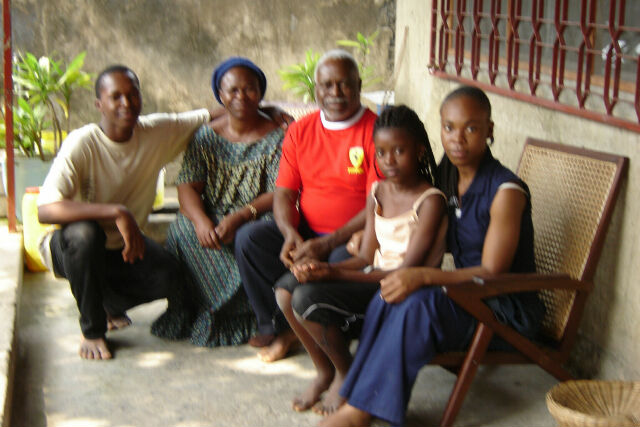 The family
The family
I settled in to a very nice bedroom – the best in the house – and then I had my first, delicious Congolese meal. And I soon began to realise that I was going to be pampered in every way by this exceptionally warm and welcoming family. This evening the meal was fried pieces of large local river fish, fried plantain and a green vegetable. I soon also realised it was not going to be possible to identify many of the fish or the green vegetables, but it hardly mattered as they just tasted good!
The only slight problem with my settling into Kokolo’s home was the fact that it was taking place in the dark. I was straightway experiencing my first Congolese power cut. The power cuts are very much a way of life there, especially in the evenings, but everyone is well equipped with oil and gas lamps. To prove the point, just five minutes before we were all about to go to bed, the electricity came back on again. But it was time for lights out, not for lights on!
My breakfast the next morning was another treat, and every meal in fact turned out to be a treat and an adventure. I couldn’t have been more spoilt. I don’t think I ever had the same food twice at lunch or dinner! My first breakfast was home-grown avocados, bread and butter and tea. I soon began to have a love-hate relationship with the avocados, however. They were absolutely delicious to eat. Never had I tasted such good, sweet avocados, but never had I been woken at three o’clock in the morning by an avocado, either. The avocado trees laden with fruit around Kokolo’s house have an unfortunate habit of dropping their fruit at night, some falling bang crash down onto the tin roof. And the tree above my bedroom was particularly laden! But although I was disturbed a bit at night by the avocados, by the truly noisy dawn chorus, and by the noisy planes passing overhead to and from Maya Maya airport, I always managed to sleep really well, and was usually the last one up!
After breakfast I had a tour of their home. The large lounge-cum-dining area is simply but well furnished: tiled floor, wooden furniture, painted walls and a wood-panel ceiling. As in the rest of the house, the windows are louvered slats of glass. The other bedrooms still have bare concrete floors and walls, a consequence of the fact that the house had been taken over by rebel troops during the civil war, and they set fire to it when they left (in 1999). Fortunately only one part of the house was badly damaged, but the rebuilding work is an ongoing process, as and when funds become available. Now all outside work is completed, and just decoration remains to be done in some rooms. At last some of Kokolo’s back pay seems to be coming through (he is still owed something like 23 months salary from the university, as is his wife), and so progress should be quicker, not only on the house, but also with the other projects the family have in Brazzaville and elsewhere.
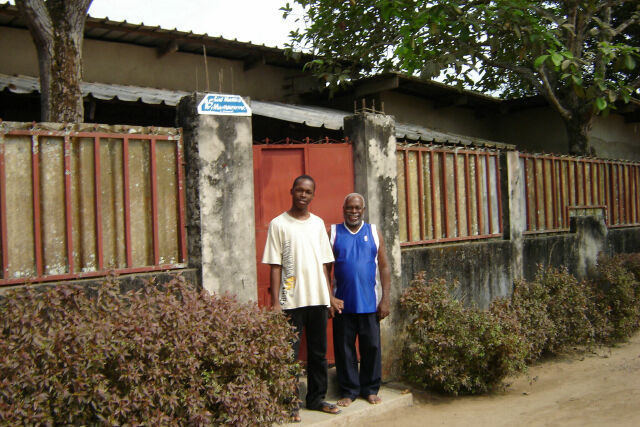
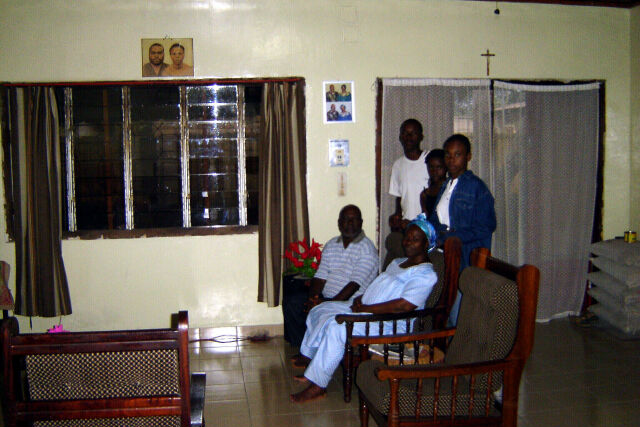 The home
The home
After the tour of the house, Geri gave me a tour of the local area, the suburb of Makelekele. We walked via a local market as far as another compound which belongs to the family where they are building a couple of small houses that they hope to rent out. Then we walked down to the side of a small river, a tributary of the Congo, with its luscious green swampy banks. All around I could spot papaya trees, lemon trees, mango trees and avocado trees. We walked further, as far as a barrage across the river which provides a source of hydroelectric power (though not when it’s needed, like the night before).
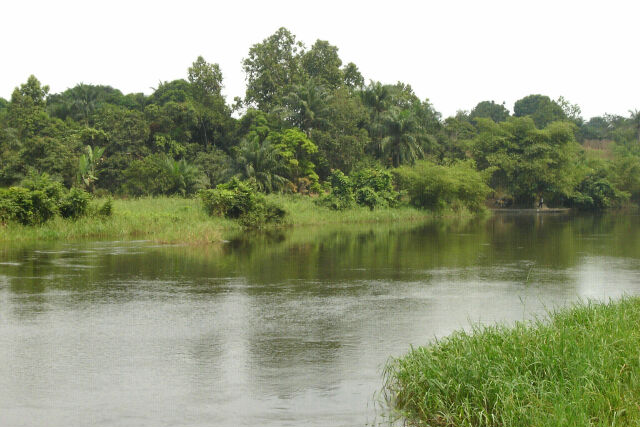 Makelekele, the river
Makelekele, the river
It was a pleasant temperature to walk in, not as hot as I’d expected, around 27 degrees maximum that day. Considering Brazzaville is just below the equator, I’d expected highs in the 30s. Instead, I was there during one of their coldest spells ever, and so many people seemed to be getting colds! I suffered, too, at one stage, particularly after a couple of really cool nights when the temperature dropped to as low as 15 degrees, and the scanty bed linen hardly sufficed. However, in many ways they were ideal temperatures for going out and about, and on many days temperature did get as high as the low thirties. But even the Congolese have reason to complain about “climate change”, it seems.
After a good walk in the morning, a delicious 2:30 lunch of fish in a tomato sauce, sweet potatoes and cabbage, I took little persuading that a siesta would be a good idea. When it’s a late lunch followed by a siesta, there’s little of the afternoon left! I’d soon got into the way of African timing, and was not at all surprised to find that their usual working hours are from 7 in the morning till 2 in the afternoon. After I’d distributed the various presents I’d brought for the family in the afternoon, and after chatting out on the veranda, it was soon time for a delicious dinner. The children were intent on watching a very silly voiced-over Nigerian soap opera on the TV (since there was electricity that second evening), but apparently each episode lasts between three and four hours, so I didn’t wait for the end.
Sunday breakfast was a delicious salad of avocados, cucumbers, green tomatoes and a dressing with fresh bread and tea. Then Kokolo presented me with a full traditional Congolese suit. The first of the many, many presents I was showered with from the family. He and his wife were already in their best outfits, so I changed to join them in the proper garb, ready for our first trip into the centre of Brazzaville. After about 20 minutes in the taxi, speeding past many official-looking buildings, we eventually got out of the taxi at the church of Ste. Anne du Congo. The largest church in the capital, it had been badly hit during the civil way and so it now only has a temporary tarpaulin roof.
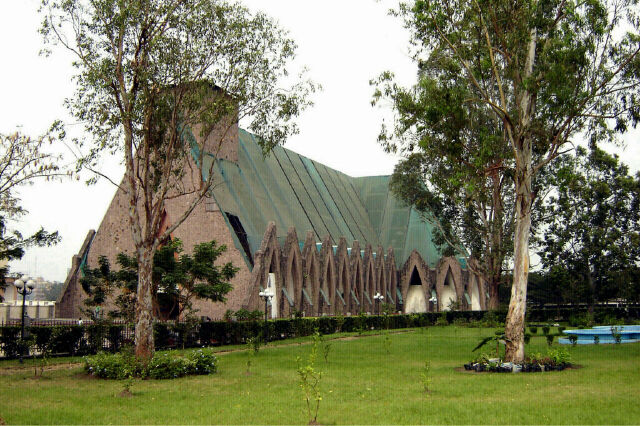 Brazzaville, St Anne
Brazzaville, St Anne
Nearby is the stadium and statue dedicated to M. Eboue, the Governor of French Equatorial Africa in the 1940s. Next stop on my guided walking tour was the railway station where trains to the coast leave from, then on past shops – mostly closed on the Sunday – to the financial area (where I was able to get some Congolese money at last).
We then walked down from the bank to the river, and I could finally gaze out over this vast, famed waterway. It is the sheer size of the river that is so amazing. Here, between Brazzaville and Kinshasa, it is between 10 and 15 kilometres wide, but at some points it can be almost 50 km wide. Upstream from the two capital cities, it is navigable for well over 1000 kilometres, but downstream there are rapids immediately beneath the capitals for hundreds of kilometres. The last stretch of the river, however, is again navigable, though the last section lies entirely within the other Congo (the Democratic Republic, formerly Zaire). We stopped to stare out over the river, to take pictures and to dip our hands in its revered waters.
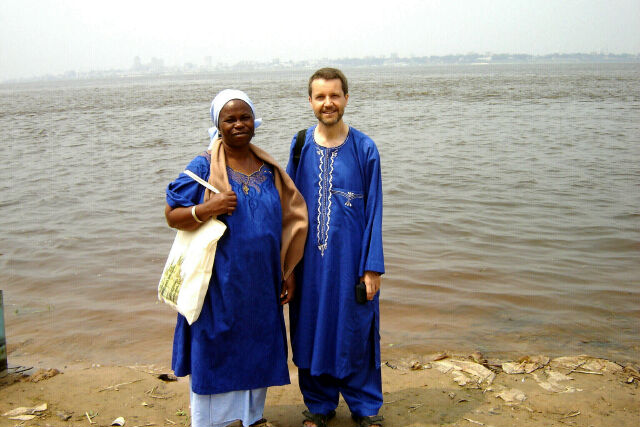 Brazzaville, Congo River
Brazzaville, Congo River
Brazzaville is a very spread-out, laid-back city, and our walking tour was also tiring in the humidity of the late morning. Guide books often compare the city to a provincial French town, and its reasonably quiet, spread-out nature with its old colonial French buildings do lend it something of a long-lost European air.
One of our next stops was a splendid tiled arch commemorating the history of the Congolese people, from the slave-trade days to modern-day independence. The horrifying figure of 55,000,000 Congolese (and nearby nationalities) were deported as slaves from the country, totally depleting its population (the population of the country today is a mere 2,500,000). Standing incongruously in front of the arched monument is an Egyptian-style eagle, a gift of the Egyptians to the Congo.
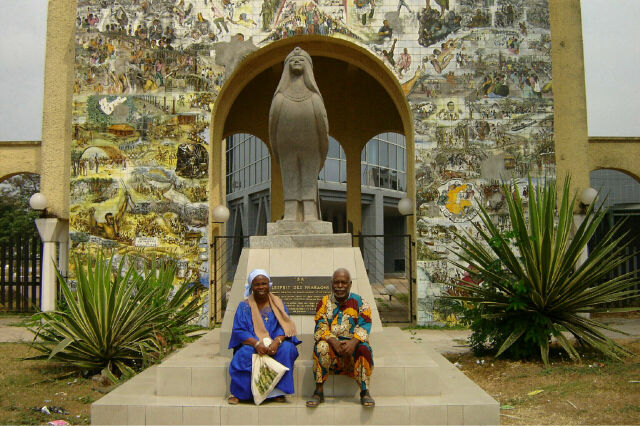 Brazzaville, arch commemorating the history of the nation
Brazzaville, arch commemorating the history of the nation
We walked on as far as the new mausoleum being built to house the mortal remains of the Italo-French explorer Pietro Paolo Savorgnan di Brazzà who opened up the Congo for the French and established the city of Brazzaville. The vast marble-clad mausoleum is almost finished, at great expense, and the remains of Brazza will be moved there from Algeria in the near future. Right alongside the mausoleum is the modern city hall (the Hotel del la Ville), and after a good bit more walking we saw the old French church of St François.
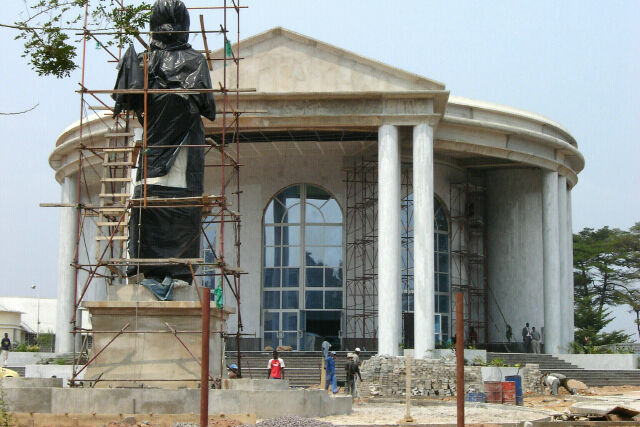 Brazzaville, The Brazza Mausoleum
Brazzaville, The Brazza Mausoleum
On the last leg of our walking tour, we passed a large building that was burnt out during the civil war and has not been rebuilt. Tellingly, the building housed the Congo Human Rights Commission. The country certainly has a pretty totalitarian government at the moment with Dennis Sassous at its head, strongly supported by the French. The very last place we visited was the Place Charles de Gaulle. I soon began to understand that de Gaulle was a local hero, having lived here in Brazzaville for four years during the Second World War. In fact he broadcast to France from here, and Brazzaville was officially termed capital of Free France during the early 1940s. Across the park from Place de Gaulle is the main lycée where Elisa had just finished studying.
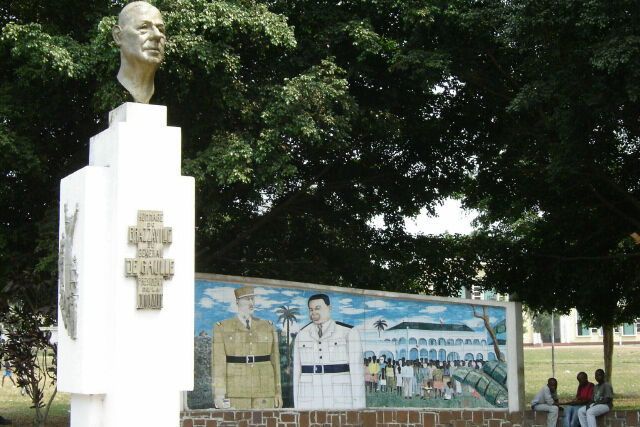 Brazzaville, Place de Gaulle
Brazzaville, Place de Gaulle
Back for a late lunch of a starter of some red baamu fruits. After peeling off the outer skin, you suck the black pips from the light-coloured pith. The flavour is a bitter, salty, lemony mix, but delicious. While Kokolo, Elisabeth and I had been touring the city, Elisa had expertly prepared a lunch of sea fish, yams and a red “oseille” (sorrel) sauce with other unusual but delicious green vegetables. Dessert is always fruit, this time a fresh pineapple.
When I awoke after my siesta, Bertille, Kokolo’s eldest daughter had arrived. She is a nun who lives and works in France, but was across in the Congo for a holiday, a treat she only is allowed once every two years. She’d been down to the country’s second city, Pointe Noire, visiting family members there, but was now back in Brazzaville for the last 10 days of her stay.
The next day was another day exploring the city of Brazzaville. After dropping Elisabeth off for her last day at work for the holidays (even if it was a Monday, it was 31st July, so the last working day), we continued by taxi to the cathedral. Smaller than Sainte Anne’s we’d seen yesterday, it had been built by the French in 1892, so was quite old, at least in parts. With its stained-glass windows and side chapels, it was the most European-like church I saw.
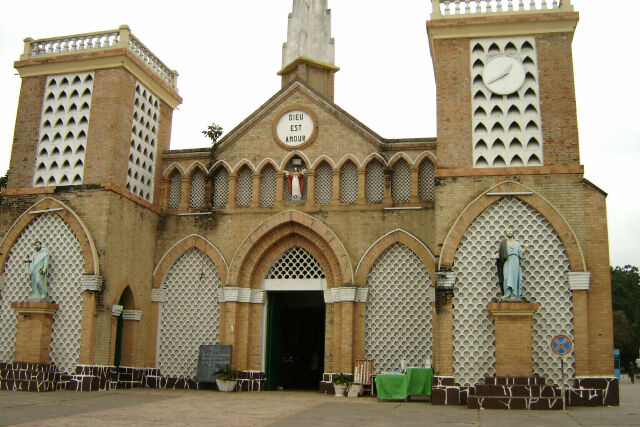 Brazzaville, Cathedral
Brazzaville, Cathedral
Outside the cathedral we had a good view over the lower part of the city, including the low old broadcasting building with its tall aerial where de Gaulle had broadcast from during the war. Not far away was the Faculty of Letters building where Kokolo had taught for many years.
A long walk took us as far as the district of Poto Poto, famous for its market and its painting school. The painting school is a large tall-roofed building in a large area with trees and bars. On the veranda that completely surrounded the school building, painters were working on their large canvases, and inside a number of excellent painting were on show. Unfortunately the prices of the paintings were very high. On the other side of the road we caught a minibus for a few stops, getting off at a haunting monument of tall headless women, commemorating the innocent victims during the recent civil wars.
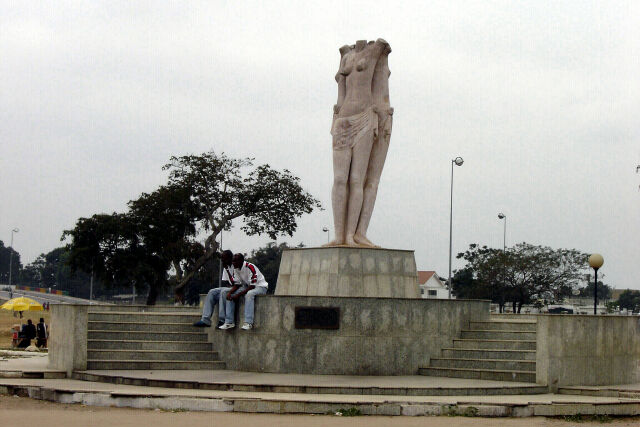 Brazzaville, Monument to the Civil War
Brazzaville, Monument to the Civil War
Walking along a wide road flanked by eucalyptus plantations, we soon came to the modern parliament building and the vast city stadium dating from the 1960s. Back to a lunch of safu fruit, smoked fish in a peanut sauce with a green vegetable and fufu (rubbery balls of manioc flour cooked in water).
Now that Bertille was also back at home, I started getting her special attention, too, which meant a special cooked breakfast made by her. The pampering just got greater! Today was our day to see the great Congo river at really close quarters. We first took a taxi to the WHO complex. This is the headquarters of the WHO for the whole of Africa, a vast complex of offices, residential areas, even a golf course. It is very close to the part of the river where the rapids and cataracts begin, and this was our next port of call. The fast-flowing, lashing currents over the rough rocks were an amazing sight. At this point there were many small islands in the river and it was difficult to get a sense of its vastness. Even a small tributary crossed by an old bridge had some very churning sections, but at the side there were women washing their clothes and men washing their cars and trucks. Slightly higher upstream, there were many flat rocks where we could walk out towards the thrashing waters.
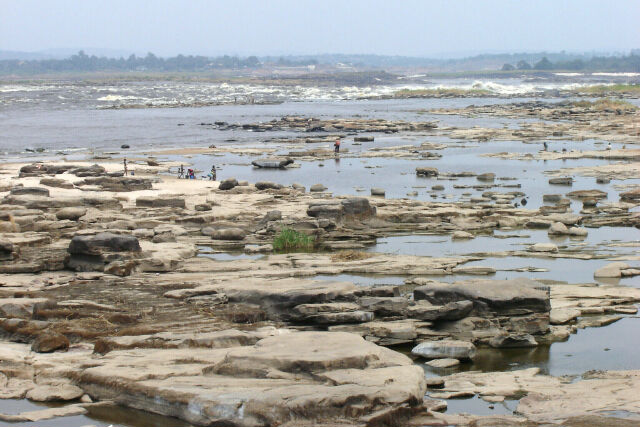 Brazzaville, rapids on the River Congo
Brazzaville, rapids on the River Congo
Higher upstream, we went to a vantage point where the French ambassador’s residence stands. It was the house where de Gaulle lived during his stay in Brazzaville, a large villa surrounded by a luscious garden and very high walls with sentries on duty. The view from this point is magnificent, up towards the centre of Brazzaville on one side, out to Kinshasa on the other, and up towards Stanley Pool – the vast natural lake that is formed in the river above the twin capital cities.
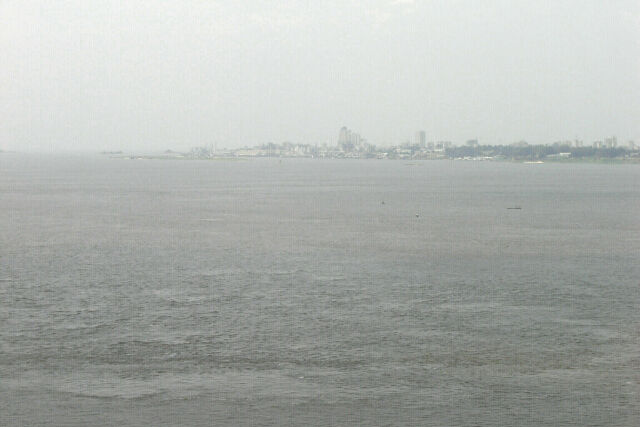 Brazzaville, the River Congo, looking across to Kinshasa
Brazzaville, the River Congo, looking across to Kinshasa
While we “oldies” had been out, the younger generation had been working hard preparing a very special lunch. And so I got to try the famous dish of Saka Saka for the first time: pounded cassava leaves, mixed with some chopped onion, flaked smoked fish and peanut butter. This was served with fried fish and cassava tuber (manioc). Dessert was a kind of small tapering banana … a pithier and sweeter taste than other bananas I’ve eaten before. After siesta, Kokolo’s sister, Denise, came to visit, and also to help prepare a speciality of hers of ground pumpkin seeds for a future meal. And the next day I also met Kokolo’s only brother, Remo, but the day was also memorable for the delicious Monsieur-dame fish cooked in a leaf parcel served with yams, green beans and the delicious crushed pumpkin seed cakes. It was a relaxing day for me before our trip to the coast the next day, but Bertille had had a busy day shopping.
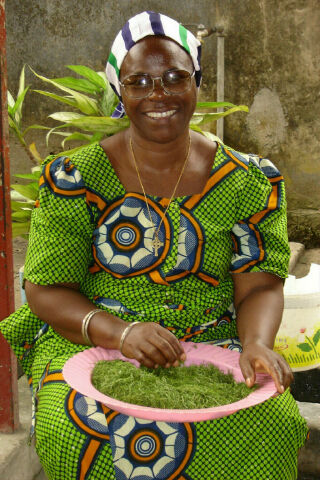 Preparation for the meal
Preparation for the meal
She’s the bargainer, I’d been told, and I was presented with various wonderful things, including an embarrassingly beautiful set of wooden carved animals to bring home. In the evening, we had another person at the lamplit dinner table. This was Delordì, Kokolo’s ten-year old granddaughter who we would be taking down with us the next day to Pointe Noire to go and live with her father (Kokolo’s eldest son Teddy).
The taxi came to take us to the airport a little before 8:45 on Thursday 3rd August. It was a long wait at the check-in, while Kokolo did all the necessary. He was angry when he explained that our boarding cards didn’t have actual seat numbers. It transpired that at the last minute some government officials decided they needed to travel on our flight, and so some passengers were being delayed. But at the check-in they had also explained that as a number of children were travelling on the flight, they could be put three-to-a-double-seat, thereby creating extra spaces (and with little regard to safety), and so we might manage to get on the plane nevertheless. So we went through into the departure lounge, and at 11:30, about half an hour later than scheduled, we went to try and board the plane. There were actually ten of us not allowed on, and only a couple actually got the extra seats, and we were told we’d be put on the next flight at 3:30.
And so it was a very long lunch-less wait in the crowded departure lounge with one very smelly toilet and one small exorbitantly-priced bar! We bought ourselves some water and a packet of biscuits for Delordi, and waited. Delordi and I passed the time playing noughts-and-crosses, dot-to-dot and other children’s games, which all were new to her. She seemed to have taken a liking to me, as she’d held on to my hand from the moment we’d got out of the taxi at the airport. Although she didn’t really show it much, there was a lot of trepidation in her for this journey: her first flight, leaving her mother and grandparents, going to live with her father and a “new” mother in a new city, leaving her school friends behind …
Eventually we walked out to our plane, an hour later than scheduled at 4:30, just 7 ½ hours since we’d got to the airport! This time we had no problems boarding the 40-year-old Antonov AN24-RV model. Decorated outside with African animals, inside it had fake tiger-skin seats that had lost most of their springing, fake leopard skin decorations on the walls and so on. When everyone and mountains of luggage had been packed in, even obstructing the doors, we set off for a very good 50-min. flight, despite the age of the aircraft.
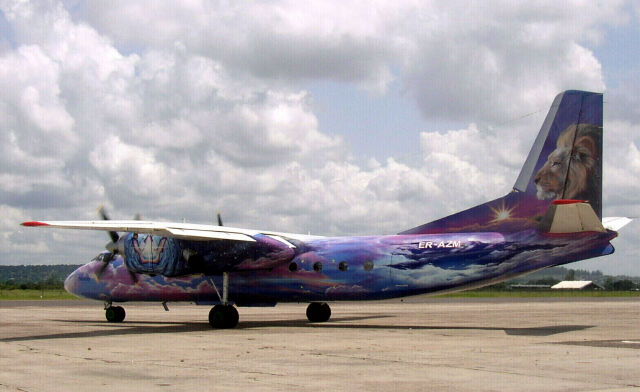 Aeroservice Antonov AN24
Aeroservice Antonov AN24
If the airport facilities at Brazzaville were basic, the old hangar that was being used in Pointe Noire was truly primitive, though next door stood a spanking new building yet to be opened. We were met at the airport by Calixte, Kokolo’s sister’s driver, and by Teddy, Delordi’s father. And quickly we said temporary goodbyes to Delordi and Calixte drove us off through the heavy evening traffic to Kokolo’s compound. Soon after we arrived, Flore, one of Kokolo’s sisters arrived to welcome us, and to bring us something to eat for dinner. She was accompanied by her daughter Cristelle and her son Dieuveille, as well as Flor’s son, Mignon.
Kokolo’s compound, like all compounds in Congo it seems, was bought as an empty plot of land where gradually rooms and houses are built. There were three small houses on Kokolo’s Pointe Noire plot, two that are rented out, and a final half-built one where Kokolo and his family live when they come down to the coast every year or so. I slept in a separate room, and the very basic toilet and washing facilities for all the houses were again a separate building.
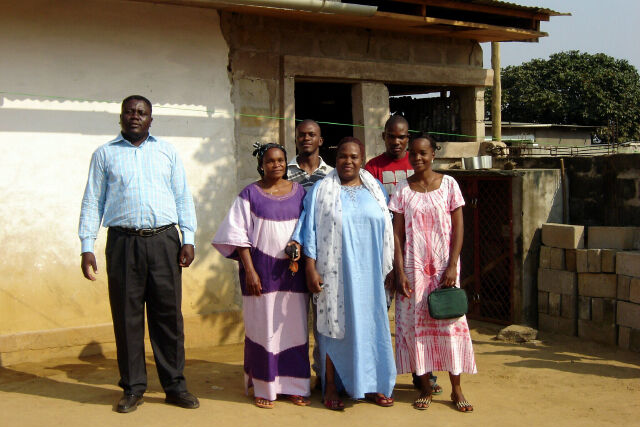 Pointe Noire, compound, with Flore, Albertine, and others
Pointe Noire, compound, with Flore, Albertine, and others
There are good views from the compound across the town and out to the coast. The next morning Kokolo and I first walked just a few hundred metres to Flore’s compound with her wooden house, and then we walked along the sandy main road in the area, around a massive landslide which had occurred some time ago and had completely blocked the road, to the tarmac road leading into the centre. We got a taxi into town, alighting at the station, an impressive north-European style building built by the French in the 1930s. This is the end of the line for the train from Brazzaville.
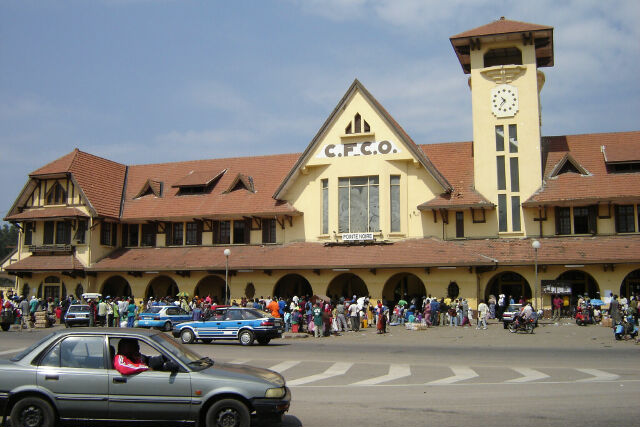 Pointe Noire, CFCO Station
Pointe Noire, CFCO Station
Just behind the station lies the city’s beach, a long expanse of fine sand. Unfortunately in the distance at one end of the beach is the country’s main port, and at the other end is a broken-down metal pier, making for a not very pretty sight. Near to the station, outside the post office was a local art exhibition, where I bought some hand-painted cards. And then we started a long walk along the town’s main thoroughfare, Avenue Charles de Gaulle. Just about everything of any importance seems to be along this road, monuments, a market, shops, the town hall, the headquarters of the railway company, the offices of ENI Congo (looking after the Italian state oil company’s interests in the country) and so on. A couple of kilometres later, and rather tired, we were picked up by Teddy in his taxi.
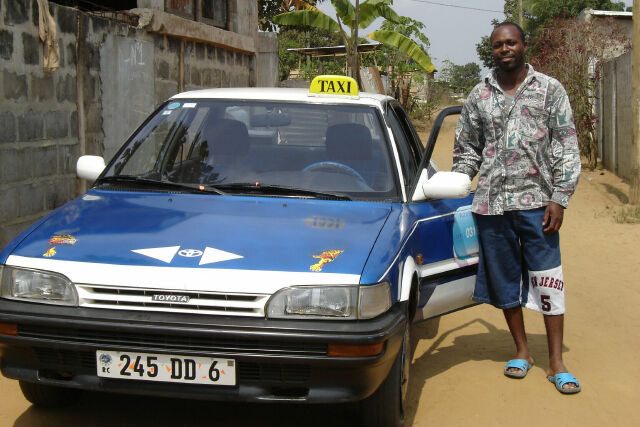 Teddy and his taxi
Teddy and his taxi
After a quick wash back at Kokolo’s compound, we were again taken by Teddy in the taxi into town, to meet up with Kokolo’s eldest sister, Albertine and her driver Calixte. We drove out of the town, along the coast to a little restaurant overlooking the most beautiful stretch of unspoilt coastline where we were intending to have lunch … except that it was closed! We drove further along the coast, stopping off at little bays, trying other restaurants, but all to no avail. The coastline is really splendid along there, and so it was a treat to be able to look at the views, especially near the Bois des Singes (the Monkey Woods).
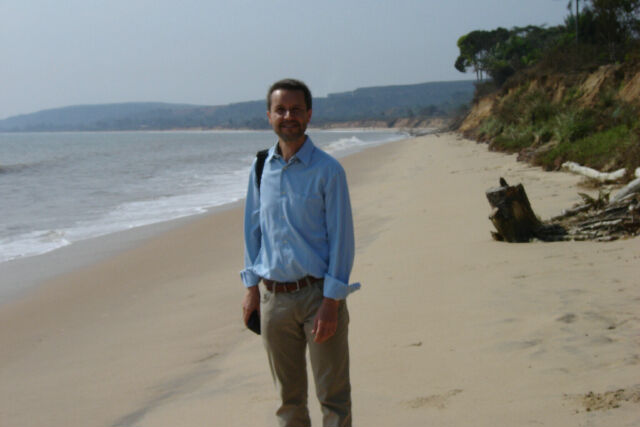
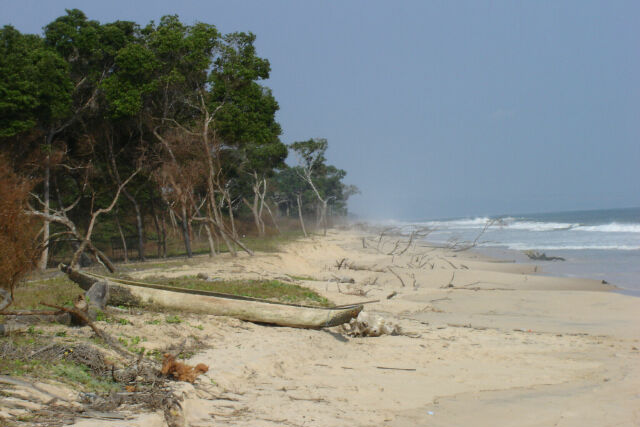 Bois des Singes
Bois des Singes
We even drove as far as the Kouilou river, but food was not to be found anywhere. So we headed back to the town, and eventually at around 5 o’clock found somewhere to have some lunch! It was just about worth the wait, as it was a very pleasant meal.
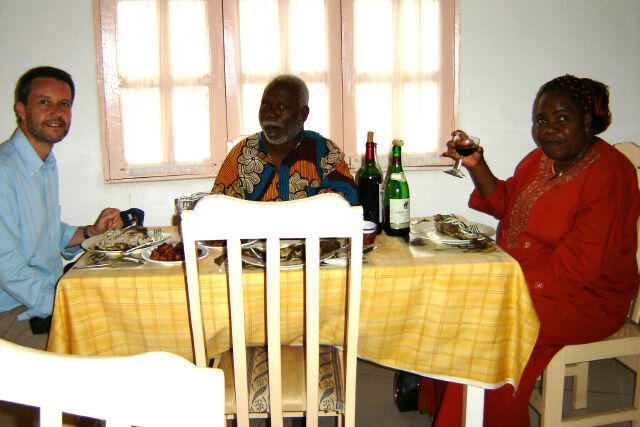 Pointe Noire, restaurant with Albertine
Pointe Noire, restaurant with Albertine
We went back to Albertine’s house, sat on the porch in the dark (power cuts are even more common in Pointe Noire), before Calixte finally drove us back to Kokolo’s compound. The next day involved a drive out through the city in the opposite (south) direction, through vast managed forests of eucalyptus trees along wide sandy tracks to a large lake, Lake Nanga, very picturesque with its wooded shores and fishing villages.
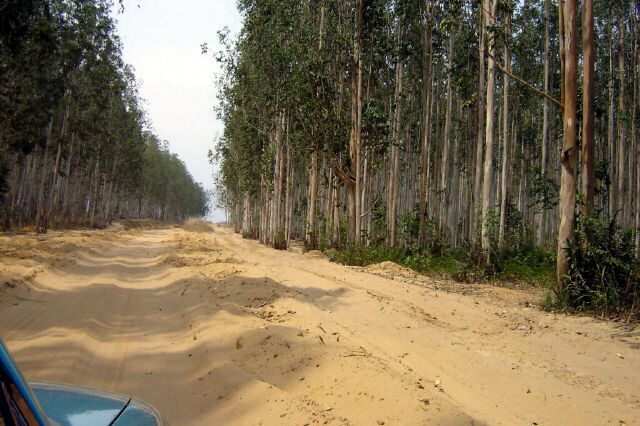 Eucalyptus forests en route to Lake Nanga
Eucalyptus forests en route to Lake Nanga
After re-tracing our route in part, we then drove past the country’s main refinery, through papyrus swamps and all the way down the coast as far as the border with Cabinda, the Angolan enclave on the coast between the two Congos. Again this is an area of beautiful coastline, but the border was nothing exciting, just a busy frontier post with lines of lorries waiting to go through customs procedures. Back at Kokolo’s compound, Flore provided us with a delicious 3 o’clock lunch of fresh crabs, cassava tubers (manioc), shrimps, safu and other greens (moussosso). We needed a siesta after that!
The next day, the Sunday, we briefly met up with a colleague of Kokolo’s who had also been in England doing courses and who I’d met many many moons ago. Fidel kindly accompanied us in his car to the main city market, where he dropped us off and went on to church. The enormous, busy market is divided into many sections: beautiful hand-made wooden furniture, ironmongery, clothes, shoes, vegetables, and then the fish. We met up with Teddy and Flore there, and Teddy took us to the Hotel Prestige where Albertine’s husband François lends a helping hand to look after the place on behalf of his brother who is in France. We were invited to an excellent and very special lunch at Flore’s, and as we were finishing Teddy, Delordi and Valerie (Teddy’s expectant second wife) arrived. Another siesta and another power-less evening completed another full day.
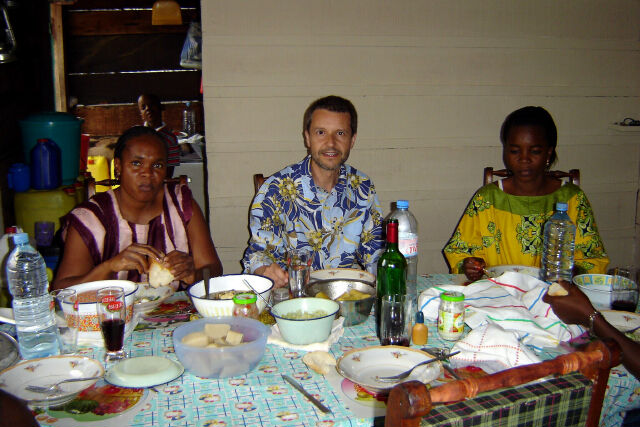 Meal at Flore's
Meal at Flore's
Already it was the day of our departure from Pointe Noire, but we were booked on a late afternoon flight, so Calixte took us in the morning to another fabulous stretch of beach with a small resort village called Malonda Lodge. We skirted the lodge and walked out, past the lagoon-like estuary of the Malonda river, onto the most wonderful deserted stretch of fine golden sand. Like the rest of the coastline here, however, the currents in the rough sea were very strong, and it was impossible to more than just paddle.
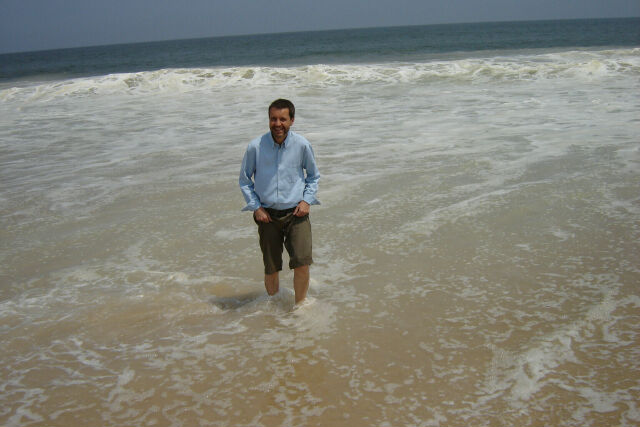
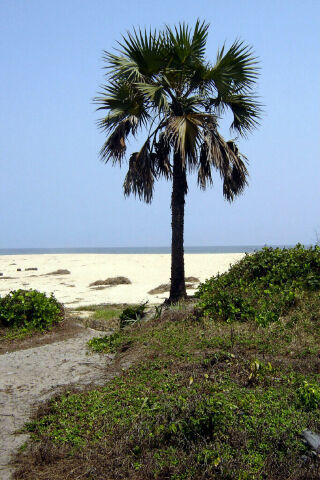 Malonda
Malonda
On our way back into town, we stopped to visit cousins and relatives, and just after lunch we had a round of visitors: Teddy, Flore, Cristelle, Albertine, Shaldie and Gaga (her eldest daughter and son) and Franck. And then it was time to get to the airport.
But things didn’t go quite as planned. Despite this being a much larger, there were 25 people who were not allowed to board because of overbooking (due again to last-minute officials who just present themselves and let the airline know that if the don’t get a seat, the plane won’t be allowed to leave). And so we had to go back to Kokolo’s compound and arrange for Teddy to pick us up the next morning at 5:30 to get the first flight out the next day.
This time we left, though rather late because of early-morning fog. The TAC plane was newer – a Boeing 737, perhaps just around 15 years old – and the journey was fast and smooth. By around 10 o’clock we were back in Kokolo’s house in Brazzaville. It was time for a third breakfast – a banana in Pointe Noire, a croissant and passion fruit drink on the plane, and an excellent feast back in Brazzaville of herbal (bulukutu) tea, banana fritters and peanuts and some more of the delicious fresh avocado spread on bread. The morning was spent telling the rest of the family all about the time down at the coast, and soon it was time for more eating, a lunch of smoked fish cooked with vegetables and mushrooms, accompanied by fufu and green beans. In the afternoon, Geri accompanied me into the city to buy stamps and some postcards, though we had to go to quite a few shops before I found anywhere selling cards.
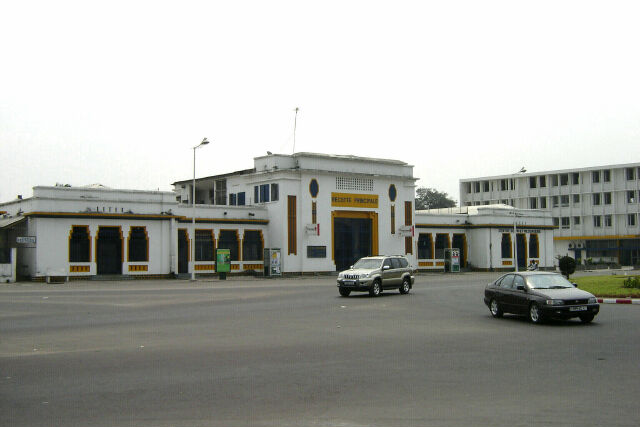 Brazzaville, Central Post Office
Brazzaville, Central Post Office
Our last stop was at the French Cultural Centre to use the Internet. However, the incredibly slow connection coupled with a French keyboard meant that it took me well over an hour to quickly check my email and write one short circular to friends and family! Every time I opened a new page I just sat back and waited for all the components to load one at a time. Still, slowly but surely I did manage to keep in contact with people in Europe.
The next day both Geri and Bertille accompanied me into the city, mainly to do some shopping. Bertille was a wonderful help as she is such an excellent bargainer. We spent most of the time at the Plateau market, where I managed to buy quite a good number of things I wanted for presents: trays, dishes, salad servers, as well as the kuba raffia mats. There was a French lady hogging the kuba stall and we walked around the market a few times waiting for her to finish, which she didn’t seem to be doing. So in the end we also started hunting through the piles of mats. In the end we got talking to her, and she spoke good English. Only when she’d left, having bought a number of mats, did the stall holder tell us she was the wife of the French ambassador. The stall holder also assured me that he wasn’t charging me the same prices as those the ambassador’s wife paid … just as well!
Back home, we spent the latter part of the morning taking bulukutu leaves off the stalks and making them up into parcels for me to bring home. Another delicious lunch awaited us: a stew of salted fish in a tomato sauce with yams and tiny green aubergines, and dessert was a delicious sweet custard apple. After a full morning, it was a siesta in the afternoon and a power-less evening, reminiscent of Pointe Noire!
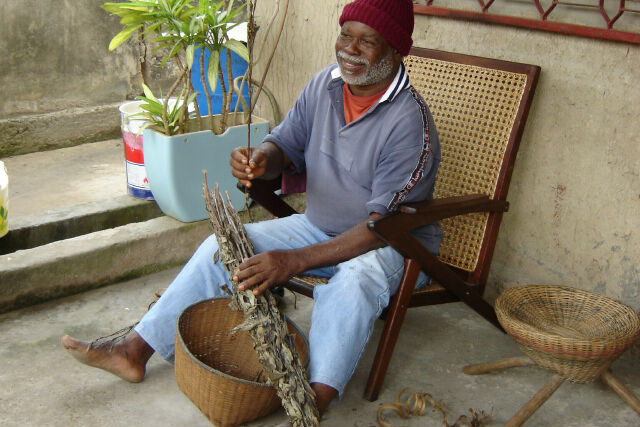 Preparing the bulukutu leaves
Preparing the bulukutu leaves
The following day, August 10th, was Bertille’s last full day with her family. I accompanied Kokolo and Elisabeth to the market for some vegetables in the morning; Bertille also went out to another market, and came back with all kinds of presents for me to bring back for the family … it was all very embarrassing! A day or two earlier I’d told Kokolo I’d like to take the family out for a meal, and I’d like to include Bertille in the event, and I’d suggested this might have been the ideal day. They’d had a family conflab, and came back to me with the suggestion that we didn’t go out to a restaurant – which tended to be expensive – but that instead I gave them some money so that they could buy some special treats that normally they wouldn’t want to afford. Of course I protested that I also wanted to give Elisabeth and the daughters a day off cooking, but they insisted that they preferred it that way.
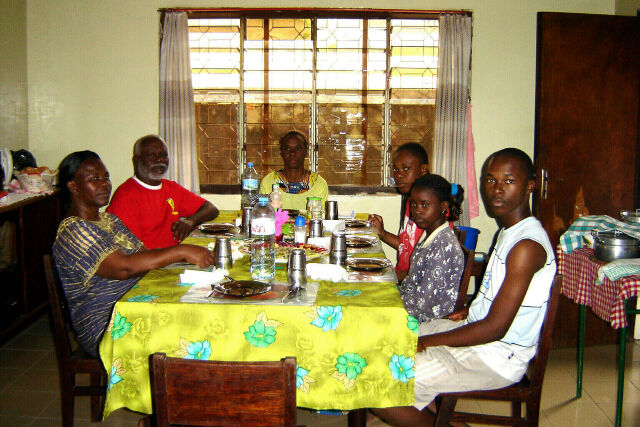 Mealtime
Mealtime
And so we had a salad as a starter followed by a very tasty yellow-fleshed fish accompanied by vegetables, rice and pounded plantain that Kokolo had spent time preparing. Dessert was a mango compote. We spent a good bit of time preparing bits and pieces (mainly foodstuffs) for Bertille to take back with her to France, including another few packs of bulukutu tea.
The next day was supposed to be a real scorcher, with temperatures up to 35°, but it was overcast for a lot of the day and never got very warm, though we did sit out on the veranda until well into the evening. Kokolo began the morning by climbing onto the roof to pick the day’s windfall avocados, and came down with over 20, most of the fairly ripe.
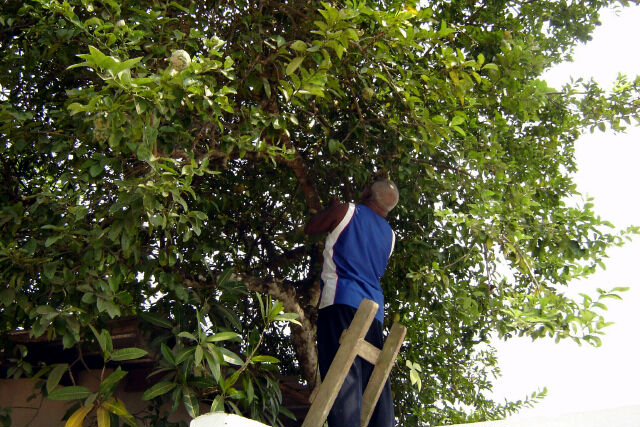 Kokolo gathering avocados and lemons
Kokolo gathering avocados and lemons
Bertille finished her packing and had her plaited before going to the airport to check her bags in. I walked with Kokolo to the copy shop where he’d had a letter typed to give notice to the tenants in Pointe Noire, but most of the rest of the day was spent with the family getting everything ready for Bertille’s departure. She had a bit of a problem at the last minute as heavy traffic prevented the taxi she’d ordered from getting to her, and so she and her brother and sister had to scoot along to the local taxi rank to get one there. Fortunately they managed without too much difficulty. It was a rather quiet, a slightly sad dinner that evening, knowing that it would be another couple of years before the family would all be together again.
 The family
The family
Saturday had been arranged as the day when I would have a tour of the environs of Brazzaville. This time the taxi driver – a family friend – managed to get to Kokolo’s place without any problems. We had a four-hour tour around the city, for a total of 15,000 CFA, around the same price I’d spent two weeks earlier to get to Linate airport in Milan in all of twenty minutes. We first drove past the airport to the newest quarter of the city, the 7th arrondissment of Mfilou, where Kokolo and Elisabeth had married in the local city hall. We then drove right out of the city to a vantage point where we could look back down on the city, across to the river, though the hazy day made for poor visibility. We then drove along endless shop-lined roads to a futuristic new building, the future headquarters of Congolese TV, and we then continued down to the river at the south of the city, seeing the ferry landing stage en route.
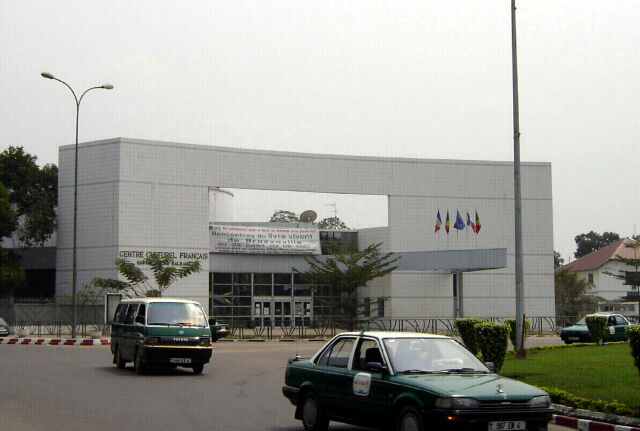 Brazzaville, the French Cultural Centre
Brazzaville, the French Cultural Centre
There were lots of things to see on our tour, from the brewery to the president’s private villa, to schools and a monument to mark the end of slavery. We had a walk around the Marché Total, where we bought a few things, but I refused to allow Kokolo to buy me any of the huge maggots which he assured me would make a very tasty lunch, and he explained that even as a vegetarian I would still be able to eat them, as “there is no meat on them, they are just all fat.” I put my foot down on that one, and would have put it down on the maggots, given half a chance. We also went to one of the city’s top pastry shops, where Elisabeth bought some cakes with the last of the money I’d given them for the previous day’s meal.
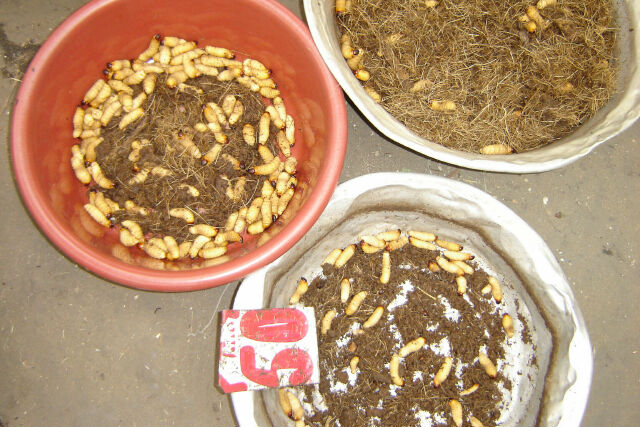 Maggots
Maggots
The last half an hour was spent driving around looking for a maker or stools, as I’d mentioned I fancied bringing one back with me. We were not successful, and I’d given up hope, when almost back home we saw a stool-maker by the side of the road. He hadn’t been there any other day, so it was a real stroke of luck. I had a good look at the stools from the car, but I was left in the taxi while Kokolo and Elisabeth went to buy the chosen one for me, as the price would have doubled or tripled if I’d gone along. On getting the small stool back home, it fit so easily in my bag, that Elisa was despatched to buy another slightly larger one so I could bring two of them back with me. After that full morning, and after another delicious lunch, prepared by Elisa in our absence, a siesta was very well deserved.
The next day, Sunday, was my very last full day in the Congo. And it turned out to be a very memorable day. The alarm clock was set for 6:15, and after a quick wash and hair-wash, I dressed in my Congolese robe, and at 6:45 Kokolo and I set off for church. It was a 10 minute walk in the opposite direction from the one we usually took, though a very leafy residential area. As we got close, Kokolo explained that the congregation are building a new, larger church just over the road from the one they use now, which is actually part of a nunnery. The church currently used is far from small. It is very plain inside, a simple cross-shaped whitewashed interior with a vast wooden cross hanging at one end. The “windows” are simply louvered slats of concrete with no glass. It was a special Sunday, celebrating the foundation of the Mutuelle Catolique pour la Solidarieté Chretienne (Mucasoc) – the church benevolent organisation that Kokolo belongs to – and all the members were sitting in the front pews on the right of the main aisle in their special shirts and yellow scarves. I stood out like a saw thumb in my blue robe.
At 7 o’clock sharp, the mass began with a few introductory words and a procession down the aisle by the twenty altar boys, the priest and his assistants. The mass was conducted in a mixture of French and the local language, but more than half of the time was taken up with the singing. The choir sat on the left of the central aisles and was made up of ladies only, though the band accompanying the singing with traditional instruments was all men. The choir ladies in the front pews had books, the less well-dressed ladies behind – the illiterate ones, as Kokolo informed me – sang from memory. The singing was excellent. There were maybe around 700 people crammed into the church, with people standing in the side aisles, sitting on sills and on the kneeling stools. And when the whole of the congregation sang together with the choir, with joy and energy, and when everyone clapped to the rather complicated rhythms, bobbing and swinging together, the atmosphere inside the church was electrifying. And the energy was matched by volume, so much so that at one point when a song stopped, everyone ducked as an aeroplane was flying overhead, coming into land at the nearby airport, and it was a shock to hear the sound so close, drowned out up until that point by the joyous singing.
Two offerings were taken and many people queued up to go forward to present their donation. Likewise for communion, everyone lined up. Many of those present were visibly shuffling when the priest talked for more than a couple of minutes, probably not so much out of respect, as out of a longing to be singing the next rousing song. The melodic songs were a bit “gospel”-like, mixed in with more traditional African kinds of rhythms, but always very exciting. And at the end of the two-hour mass, I was sad it was all over, it had been such a unique experience. Leaving involved an awful lot of handshaking – I was the only white person in the church – and before going back for breakfast, Kokolo showed me the new church that is being built: the second collection had been for the building fund. The new structure now has a roof and some side walls, but they were hoping to get enough money to put in the supporting pillars for the roof before the rainy season, most of the present supports being temporary, spindly wood props.
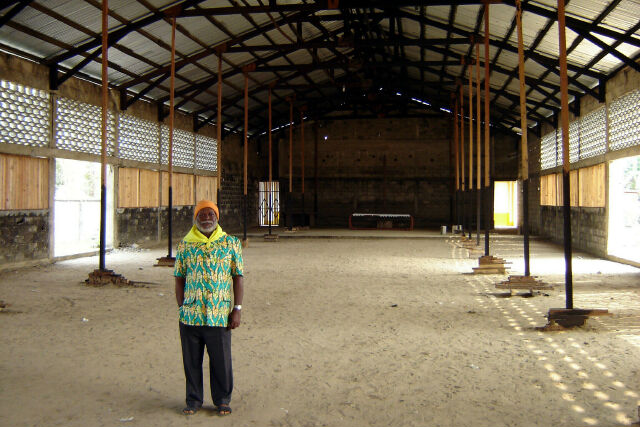 The new church in construction
The new church in construction
Naturally a delicious breakfast awaited us, and we felt ready for it. The rest of the morning was spent shelling some rather maggot-ridden beans. Before lunch I accompanied Geri to the nearby small Carmelite convent to deliver a picture of the new Pope that Bertille had left for them. Later in the afternoon I began the job of sorting out and packing … my time in Brazzaville with this over-generous family was rapidly coming to an end.
Breakfast on my last full day was the usual (delicious) avocado with banana fritters and bulukutu tea. Elisabeth was out, and I discovered later she’d been to the Marché Total especially to buy some baamu fruit for me to bring back home with me. I had little choice but to allow Kokolo and all of them in the family to stuff my bags full of avocados, yams, plantains, peanuts, peanut butter and I don’t know what else. With a weight limit of over 40 kilos on the plane, there’s a lot of “free” space!
Like Bertille a few days earlier, I went to the airport in the morning to check in, even if the flight was in the evening. It was easier to do all the formalities that way. It was busy at the airport, and I was pleased that Kokolo was there to help me. First there was a security check of passports and tickets, then tickets were checked again and bags were weighed. Then there was another queue to get a certificate from the doctor to say that all foodstuffs had been checked (not true, but the certificate cost 5,000 CFA). Then it was customs and a very light body-search and questioning as to whether I had any wooden statues (of course the answer had to be “no”, or pay another large amount). Then it was another queue at the Air France desk, and eventually the check in was over. Nearly two hours just to check two bags in!
Kokolo and I walked from the airport to the city boundary, firstly as he needed to go into a courier’s office to send something down to his son in Pointe Noire, and secondly because the taxis cost half the price from inside the city. Back home the final lunch was again special and delicious: a salad entrée prepared by Elisa, a pink dorade fish, with fried plantains, vegetables and aubergines, and a wedge-shaped banana for dessert. Just time for a short siesta in the afternoon, and time for Kokolo and family to stuff more avocados into my backpack, and then it was a last goodbye and off to the airport again. In the airport the security people discovered the avocados in my backpack and wouldn’t accept the certificate for the hold luggage. I didn’t have enough cash to buy another certificate – I’d just kept a couple of thousand CFAs for a bottle or water or something – but it did suffice to bribe the security people to let me through anyway …
The flight back was fairly easy, and we arrived in Paris about 15 minutes early. However, it took over 20 minutes for the buses to arrive to take us to the terminal, then there were endless queues inside the airport, so much so that I missed my Milan flight by a whisker. I had to get really angry with the ground staff before they agreed to put me on a mid-morning Alitalia flight to Malpensa rather than a late afternoon Air France flight to Linate. But a bit of bad tempered French somehow worked, and I was back in Milan, in my flat, by mid afternoon on the 15th. And the Congo seemed so far away again.
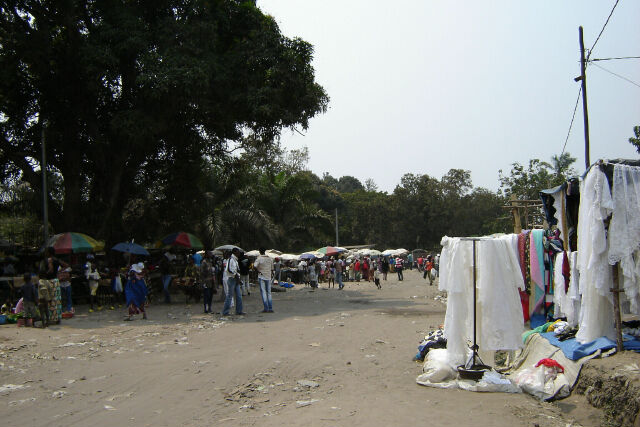 Brazzaville, Makelekele market
Brazzaville, Makelekele market
Home |
Publications |
Dictionaries |
English Lang. |
Art Insights |
Travel |
Links | ||||||